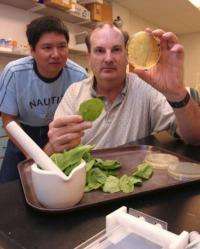With spinach, it may be what’s on the inside that counts

As investigators narrow the search for the source of E. coli-tainted spinach to just a few farms in three California counties, researchers suggest it may be just as important to examine how the plants acquired and carried the bacteria as it is to find the original point of contamination.
Conventional wisdom holds that harmful bacteria on fruits and vegetables are the remnants of contamination skulking on the exterior of the plants — easily washed away by conventional surface sterilization techniques. But University of Florida microbiology experts believe the recent rash of spinach-related E. coli infections may be instead linked to swarms of the pathogen lurking inside the leafy greens.
Eric Triplett, professor and chair of microbiology and cell science with UF’s Institute of Food and Agricultural Sciences, has previously shown bacteria that wreak havoc in the human body can peacefully coexist in a plant’s system — and sometimes at levels that can reach 10,000 cells of bacteria per gram of vegetable matter. That’s far beyond what is required to make a human very ill when it comes to pathogens such as salmonella and E. coli.
“We know that plants can take bacteria up from the soil through their roots,” Triplett said. “What we need to do now is investigate whether this is a problem with our crops, and then what we can do about it if it is.”
For food safety experts, this could mean a paradigm shift in thought about food sterilization.
“When I was a graduate student, we were taught that the insides of plants were sterile,” said Michael Doyle, director of the Center for Food Safety at the University of Georgia. “Further elucidation is needed before we can say this is a major health concern…but assuming E. coli is getting into the plant — yes, this will be a big problem to address.”
The problem, UF researchers say, would be twofold. The first is the question of how to keep dangerous bacteria out of water and soil in the first place. The second is how to eliminate a pathogen if it does infiltrate crops.
“Given the relatively low frequency of these types of outbreaks, I’d say the USDA and our growers are doing a pretty good job of keeping bacteria in check,” Triplett said. “But outbreaks like this happen every one to two years, and everyone is kind of left scratching their heads.”
Produce such as spinach is typically washed in a solution of chlorine and water. But this does nothing to affect the interior bacteria. Researchers with UF’s Emerging Pathogens Initiative EPI are exploring how bacteria exist in crops and how they can be controlled. Past research has involved exploring how gaseous ozone and irradiation can be used to destroy potential interior pathogens. However, the EPI, which received $21 million in funding from the Florida Legislature this year, won’t stop there.
“Our goal is to fully explore the cause of these types of problems, vet them out fully, and then find all potential solutions, not just the obvious ones,” said Doug Archer, former deputy director of the Food and Drug Administration’s Center for Food Safety and Applied Nutrition and an EPI advisory board member. We may simply be able to give the plants themselves the tools to fight infection.
“It is natural for plants to have bacteria in them, they have learned to use it in many ways to get nutrients that they have trouble getting from the soil or water,” said Zhonglin Mou, a microbiologist with UF’s Emerging Pathogens Initiative. “So, they have ways of controlling bacteria that we can use.”
Mou is working with natural, non-genetically-modified-organism methods to adapt plants’ metabolic pathways so that their natural immune system is given a boost that can eliminate harmful bacteria. He hopes to receive a patent on his work in as little as six months.
Further work must be done to determine the health risks associated with internalized bacteria. For now, Triplett and Doyle say, the best bet is trusting in the already well established safeguards.
“But I’ve been around long enough to see that things can change as the science evolves,” Doyle said. “The old rules — that we have long gone by — no longer hold because the science supports new concepts. And this could be one.”
Source: University of Florida

















